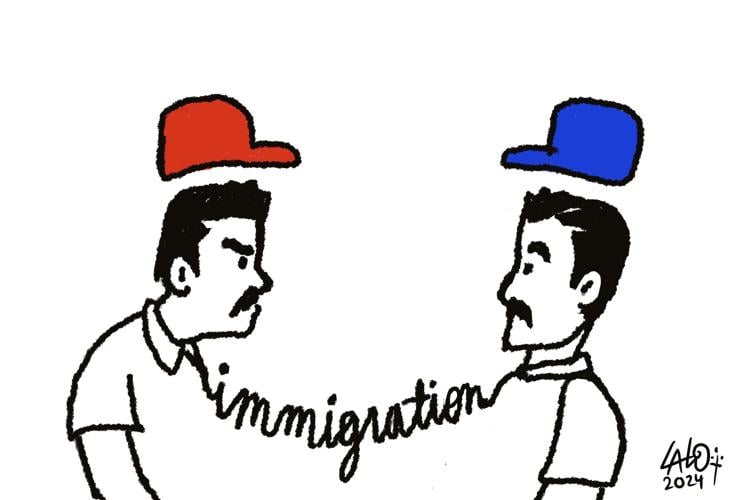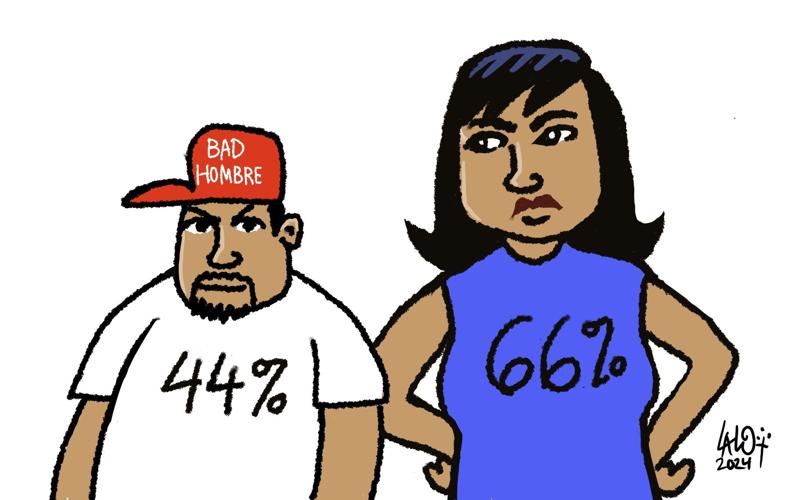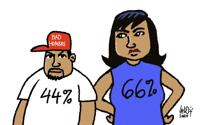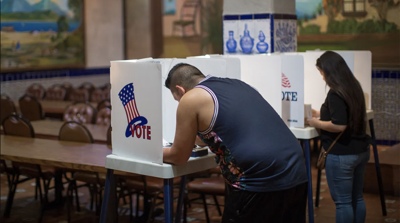Get stories like these delivered straight to your inbox. Sign up for the CALÓ Newsletter.
Early post-election polls raised concerns about a troubling trend: an increase in male Latino support for former President Donald Trump. While this statistical shift has garnered significant attention, it also raises important questions about how we understand Latinos as a categorization, and how we can avoid reducing a diverse group of over 60 million people to a set of broad, often misleading generalizations.
Polling data, especially in the heat of a contentious election cycle, often paints a reductionist picture of a complex electorate. The rise in Latino support for Trump, while noteworthy, risks obscuring the diverse factors that shape political preferences within this community. Latinos, by virtue of their racial, socioeconomic and cultural differences, do not form a monolithic voting bloc.
Such complexities are not always visible in the data. Polls often reduce the Latino community to broad categories based on race or country of origin, when in reality, the factors influencing Latino political behavior go far deeper.
Unpacking the shifts in political affiliation among Latino men
The rise in male Latino support for Trump doesn’t translate into a unified shift in the community at large. It highlights how dangerously oversimplified our conversations about the Latino vote have become, especially when some of the most vulnerable populations exist within the umbrella of “Latinidad.”
This is not to say that there aren’t much-needed conversations about how machismo is deeply embedded in our culture; in fact, this cultural norm is partly tied to the religious sentiments many Latinos hold, particularly when it comes to issues like abortion and reproductive rights.
The prevailing issues of misogyny, sexism, anti-LGBTQIA+ sentiments and anti-Blackness/Indigenous rhetoric taking place within the community are evident to most Latinos. Take, for example, the 2022 incident involving Los Angeles City Council members Kevin de León, Gil Cedillo, and former Council President Nury Martinez. In a leaked recording, the council members were caught making racist remarks and scheming to manipulate the city's redistricting process.
During the conversation, Martinez, De León and Cedillo were heard mocking Oaxacans, laughing as they made derogatory comments. The scandal sparked widespread outrage and led to calls for their resignation.
The conversation exposed troubling parallels between the colorist and racist attitudes held by some members of the Latino community and the white supremacist ideologies that perpetuate such prejudices. The rampant colorism within the community is deeply intertwined with negative stereotypes of migrants, many of whom are fleeing violence and instability in war-torn countries. This reflects a broader, often uncomfortable reality: that discrimination and xenophobia are not limited to one racial or ethnic group, but can also be perpetuated within marginalized communities themselves.
This is why categorizing Latinos into one data set is a failure to capture the depth of intra-community differences as well as to highlight the struggles of the most vulnerable Latino groups. Immigrant communities—many of whom are wary of the former president's hardline immigration stance—remain largely opposed to him.
However, according to The Pew Research Center, Latinos also widely agree that the U.S. immigration system needs reform, with a significant portion calling for major changes (53%) or a complete overhaul (29%). Many of those most directly impacted by said immigration policies are unable to vote, making it difficult to capture an accurate picture of the numerical demographic of non-voting Latinos opposed to the Republican platform.

(Illustration credit: Lalo Alcaraz)
The data trends reveal notable divergences within the "Hispanic" or "Latino" electorate. According to a policy brief from UnidosUS and the California Civic Engagement Project, women make up 49.5% of the total Latino population in the U.S., meaning Latino men slightly outnumber Latinas. However, despite not being the majority gender, Latinas have consistently voted at higher rates than their male counterparts. Latina voters, especially those from working-class or immigrant backgrounds, have shown a consistent preference for candidates who prioritize healthcare, education and reproductive rights.
Similarly, LGBTQIA+ Latinos, many of whom face discrimination from both mainstream society and within their cultural spheres, are deeply critical of Trump's policies on civil rights.
How simplified views of Latino voters mislead political forecasts
Early polling results, especially when parsed through simplistic partisan lenses, often miss the nuance of what is happening on the ground. While some analysts have interpreted the dip in voter participation as a sign of growing enthusiasm for extremist ideologies, a closer look reveals that this shift is more reflective of the Democratic Party’s struggles to engage and mobilize its base—particularly when compared to the record-breaking turnout in 2020.
In 2020, Democrats were buoyed by a wave of dissatisfaction with former President Donald Trump and a concerted effort to energize young voters, communities of color and progressives who felt the urgency of the moment. The result was a historic turnout, with nearly 160 million Americans voting—the highest in over a century.
According to The Associated Press, during this election cycle, Donald Trump secured 295 electoral votes from 72.7 million ballots, while Kamala Harris received 226 electoral votes from 68 million ballots. This marks a decline of 1.5 million votes for Republicans and 13.2 million fewer votes for Democrats compared to the total vote count in the 2020 election.
However, these polls do not necessarily provide insight into whether Latino votes are directly influencing the outcome of the Electoral College, which is primarily determined by a handful of key swing states. While national trends can offer valuable context, it is the voting patterns in these pivotal states that ultimately decide the election.
In key battleground states such as Georgia, Michigan, North Carolina, Pennsylvania and Wisconsin, the Latino vote played an important role, but it was not large or concentrated enough in crucial areas to sway the outcome of the election. While the Latino electorate has grown significantly in recent years and continues to be a key demographic, its influence in these states remains more limited compared to other groups, such as white non-Hispanic voters. Furthermore, while there were over 36 million Latinos eligible to vote in this election—they were still only 15 percent of the total pool of eligible voters across the country.

(Illustration credit: Lalo Alcaraz)
Republican gains in key battlegrounds highlight Democratic vulnerabilities
This time around, Republicans successfully secured key states. According to Edison Research, polling data in swing states like Wisconsin, Pennsylvania and Michigan lacked sufficient sample sizes to provide detailed breakdowns for Hispanic and Latino voters. However, in each of these states, white men and women were the majority bloc, casting their votes predominantly in favor of Donald Trump. In contrast, in states like Georgia, Hispanic and Latino voters leaned heavily Democratic, with Hispanic men supporting the Democratic ticket by 53% and Hispanic women by 60%, favoring Vice President Kamala Harris.
The Democratic Party's inability to mobilize 15 million voters—many of whom came from key constituencies—points to a deeper failure to address the economic concerns of crucial voting blocs, particularly Latinos. The decline in voter participation was not evenly distributed, with disproportionately lower turnout in communities facing economic hardship.

(Illustration credit: Lalo Alcaraz)
For Latinos, many of whom are grappling with wage stagnation, job insecurity and rising living costs, the party’s messaging and policy proposals often fell short of offering tangible solutions. This disconnect between the economic realities of Latino voters and the Democratic Party's response has left many feeling disengaged and underserved, making it increasingly difficult for the party to sustain high levels of support among this vital demographic.
While some pundits have pointed to the rise of alt-right rhetoric and a more energized conservative base as evidence of a shifting political tide, the reality is more complex. The lower turnout is not necessarily a result of increased far-right enthusiasm, but rather a reflection of the Democratic Party’s difficulty in motivating its voters in the face of a relatively stable incumbent Republican campaign. Without the galvanizing force of a polarizing figure like Trump at the top of the ticket, many progressive and moderate voters simply stayed home.
















(0) comments
Welcome to the discussion.
Log In
Keep it Clean. Please avoid obscene, vulgar, lewd, racist or sexually-oriented language.
PLEASE TURN OFF YOUR CAPS LOCK.
Don't Threaten. Threats of harming another person will not be tolerated.
Be Truthful. Don't knowingly lie about anyone or anything.
Be Nice. No racism, sexism or any sort of -ism that is degrading to another person.
Be Proactive. Use the 'Report' link on each comment to let us know of abusive posts.
Share with Us. We'd love to hear eyewitness accounts, the history behind an article.